My normal morning commute has been diverted by a period of particularly intense works being carried out on a bridge, which has to be done now, because we're between the swallows (that I knew about) and the bats (that I didn't). I'm delighted that the work has been so sensitively windowed; and for all that it's added ?maybe 6 minutes to my commute, also with the change of scenery. Even the main road isn't as much of a downer as I anticipated, because of this:

What you're looking at is plants growing in the drainage kerbs that were installed after the Abingdon Road floods of 2014. While not our most spectacular floods of recent years (that's 2007) they were notable for the speed of the inundation, the disruption to the sewerage (the councils had to bring in temporary toilets for the residents) and the importation of some innovative inflatable flood barriers from Holland. There's a long term solution coming, in the shape of vast seasonal storage lakes which will take the run-off away from the cities and the villages (the current solution -- storage channels and lock-gates -- often leads to accusations of villages being sacrificed for the city, or (more rarely) vice versa, though how much can be done to shape the flow often comes down to the speed of the inundation) but that's not due to complete for a few years yet. In the meantime, multiple other works are afoot to mitigate the thrills and spills of Oxford's Isis-Cherwell confluence, from uphill tree-planting around tributary rivers, to altering building regulations to make contractors legally liable for new water-flow mishaps. But let it never be said that Oxfordshire neglects the details. These drainage kerbs are one such detail; hollow kerbs (aka kerbdrains) which whip the surface water off the roads, keeping our causeways open.
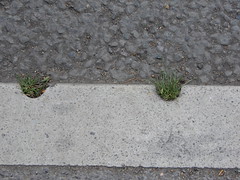
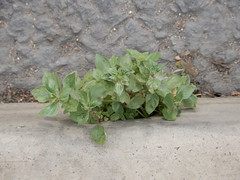
They come in both dropped and raised kerb versions. As you can see from the lush growth of escaped garden oregano in the raised kerb, there's quite a big hole there; but the shallower holes are more attractive to flat growth, like grass.

It's been a summer for the plants, with lots of sun and lots of rain, but I'm still impressed at how fast the weeds have colonised this new habitat niche.
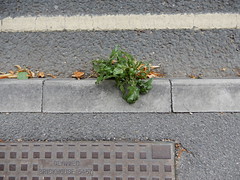

Initially I worried that the holes might be blocked by this miniature overgrowth, but that's 20th Century thinking. Flood water scours, and the loose aggregation of city-dirt and rain dust these weeds are growing in will be swept away, and the weeds with them too, should the need arise. In the meantime they add to the water-pull, a million tiny green elbows flexing to help lift the water up out of the sewer system. They're not a problem in the system, but rather a benign side-effect. Like green leaves on the branches of a deciduous tree that are lit and warmed year-round by a street light, they are part of the humaniformed environment.
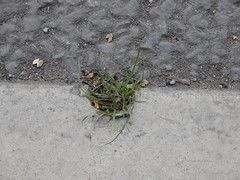
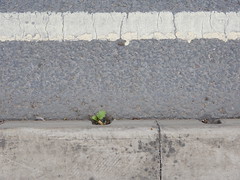
Nothing has flowers yet, but I see plenty of buds. Before autumn closes the season, there will be flowers in the gutter, and insects tumbling among the vehicle-gusts, and another thin green thread through the grey.

What you're looking at is plants growing in the drainage kerbs that were installed after the Abingdon Road floods of 2014. While not our most spectacular floods of recent years (that's 2007) they were notable for the speed of the inundation, the disruption to the sewerage (the councils had to bring in temporary toilets for the residents) and the importation of some innovative inflatable flood barriers from Holland. There's a long term solution coming, in the shape of vast seasonal storage lakes which will take the run-off away from the cities and the villages (the current solution -- storage channels and lock-gates -- often leads to accusations of villages being sacrificed for the city, or (more rarely) vice versa, though how much can be done to shape the flow often comes down to the speed of the inundation) but that's not due to complete for a few years yet. In the meantime, multiple other works are afoot to mitigate the thrills and spills of Oxford's Isis-Cherwell confluence, from uphill tree-planting around tributary rivers, to altering building regulations to make contractors legally liable for new water-flow mishaps. But let it never be said that Oxfordshire neglects the details. These drainage kerbs are one such detail; hollow kerbs (aka kerbdrains) which whip the surface water off the roads, keeping our causeways open.


They come in both dropped and raised kerb versions. As you can see from the lush growth of escaped garden oregano in the raised kerb, there's quite a big hole there; but the shallower holes are more attractive to flat growth, like grass.

It's been a summer for the plants, with lots of sun and lots of rain, but I'm still impressed at how fast the weeds have colonised this new habitat niche.


Initially I worried that the holes might be blocked by this miniature overgrowth, but that's 20th Century thinking. Flood water scours, and the loose aggregation of city-dirt and rain dust these weeds are growing in will be swept away, and the weeds with them too, should the need arise. In the meantime they add to the water-pull, a million tiny green elbows flexing to help lift the water up out of the sewer system. They're not a problem in the system, but rather a benign side-effect. Like green leaves on the branches of a deciduous tree that are lit and warmed year-round by a street light, they are part of the humaniformed environment.


Nothing has flowers yet, but I see plenty of buds. Before autumn closes the season, there will be flowers in the gutter, and insects tumbling among the vehicle-gusts, and another thin green thread through the grey.
No comments:
Post a Comment